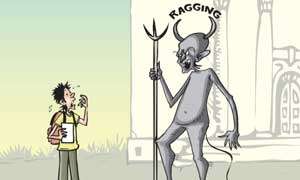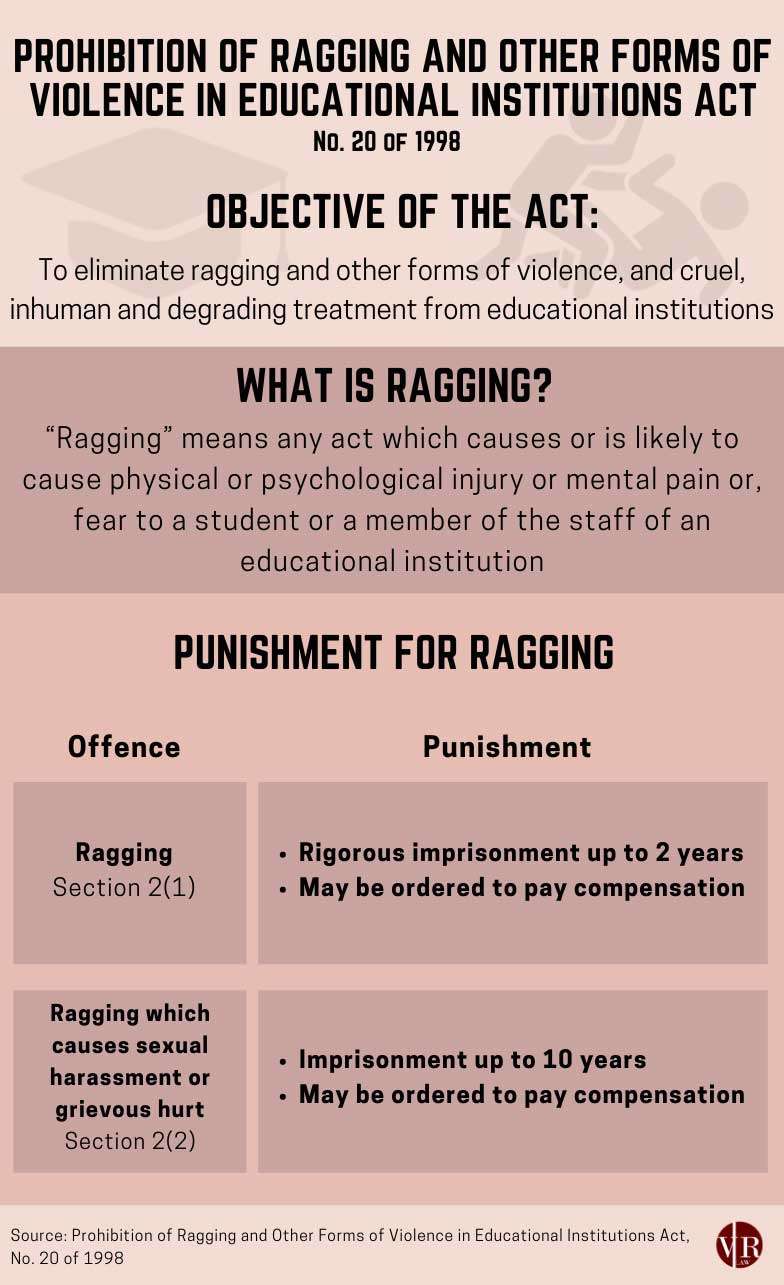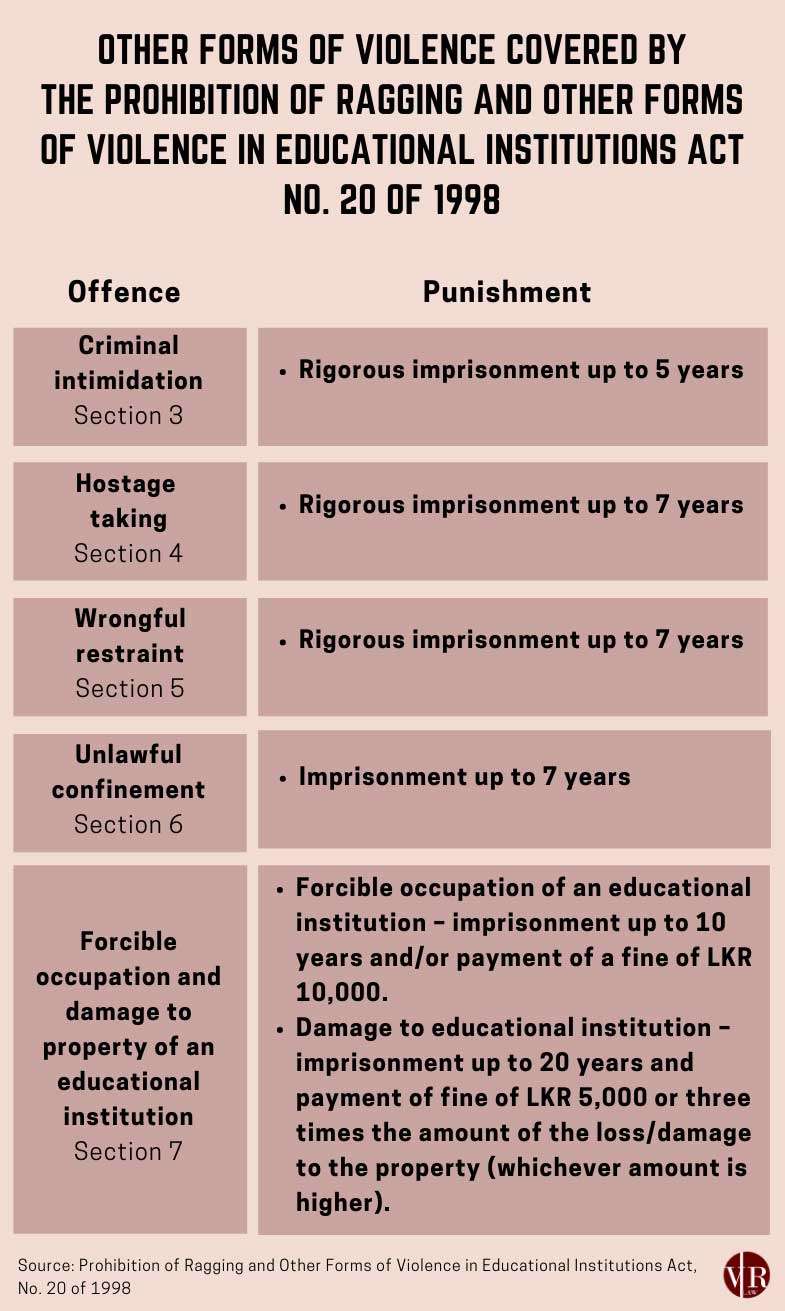
Mar 13 2020.
views 1029Pasindu Hirushan was a bright eyed fresher walking through the gates of the University of Sri Jayewardenepura full of hopes and dreams about his future. Today, he’s fighting for his life. Widely purported to be the result of ragging, Hirushan is certainly not the first to face the dire consequence of it, but will he be the last?

The Law
As a result of the incident, the university’s student union held a press conference refuting the allegations and citing it as the result of an accident. The Mirihana police subsequently arrested five students of the Sri Jayawardenapura University including the main suspect had been taken into custody for throwing the tyre that hit Hirushan on the head.
According to the Prohibition of Ragging and Other Forms of Violence in Educational Institutions Act No. 20 of 1998, ragging is a distinct and punishable offence by law. If the ragging leads to sexual harassment or grievous hurt, it is a non-bailable offence and the punishment is increased to ten years' imprisonment. Nevertheless, despite the arrests, we are yet to hear of anyone being penalised for their hand in the crimes.
In addition, there is an act that protects the victims and witnesses of ragging: Assistance to and Protection of Victims of Crimes and Witnesses Act, No. 4 of 2015. The act is meant to provide help and protection to victims and witnesses of the crime, as well as offer assistance in getting compensation from the offenders and obtaining redress (restitution, rehabilitation, compensation, reparation).


** Infographic by Verite Law
A Severe Problem
A study by the UGC in collaboration with the Ministry of Higher Education, UNICEF and other universities, titled “Ragging, Sexual and Gender based violence in Sri Lankan University system” painted a bleak picture of the state of ragging in the country. The study recorded responses from 15000 and 1550 staff members. The study found that a staggering 44-55 % of students reported that they were ragged while 28% reported sexual or similar harassment.
The “Batch Fit” Culture
Pro-raggers paint a picture of lighthearted ragging meant to inculcate a culture of equality. An ice breaker of sorts. One may be expected to sing a song, dress a certain way. They argue that it enforces “batch fit”. In fact, ragging can be stated as being an activity ‘aimed at fostering unique group identity and assimilation without legitimate operational function’. But before long, the lines appeared to blur and ragging evolved into a display of power dynamics, sending its ringleaders on a self-serving power trip. Year after year, the bar is raised, with seniors resorting to increased violence and sadistic sexual abuse. Even more appalling, seniors now rent “torture chambers” to be utilised for the purpose.
The Psychological Impact
“Ragging has been frequently associated with the broad spectrum of physical, behavioural, emotional and social problems among victims and attributed to the increased risks of suicide and drop outs among students attending Sri Lankan universities” stated Dr. N Kumaranayake, Clinical Psychiatrist & Executive Director of Life Centre. Elaborating on the history of ragging in the country, he explained “ragging is not an indigenous phenomena. It was not present in ancient Sri Lankan educational institutions. After WWII, some soldiers who served in this war entered some Sri Lankan universities and they are the ones who started this military type of ragging. Their aim was to develop team building. This was the start of ragging in Sri Lanka”.

Dr. Kumaranayake iterates that pro-rag groups today share similar sentiments, and state that their goal is to establish a social equalizing mechanism. “They say they don’t want to have any differences between students and want to create a common platform where everyone’s ideas are the same and equal. I don’t believe that. I feel that this is a kind of inferiority complex or that this is a kind of antisocial or narcissistic thinking. Human beings are unique and you can’t expect any group to have completely equal thinking patterns. These kinds of social cognitions are wrong”.
“Ragging is not a mere social problem; there is a psychological basis to it. Most senior students state they don't wish to rag juniors but succumb to peer pressure. This is a herd mentality where students can be influenced by others in their group. Few students actually want to rag anyone”, Dr Kumaranayake says, adding that the ragging that occurs often veers off to the sadistic end of the spectrum. “Sadism involves deriving pleasure through others undergoing discomfort and pain and can also include emotional cruelty. Such sadistic personalities tend to display aggressive and cruel behaviours, and the reason is they may have antisocial or narcissistic personality traits. Narcissistic people, for example, lack empathy for others, and believe others have to behave the way these people want”.
“In Sri Lanka, 60% of families face domestic violence problems. 30% of families have alcohol abuse. A large number of children are abused during childhood. As a result of these experiences, they may develop various personality disorders. These are also the same students who lead the rags and campaigns and problems”.
“Now there is a fear psychosis of entering the university. Some students, even though selected, are reluctant to enter due to the fear of ragging”. He cites examples of clients he has seen in his practice. “I still remember - one student who was selected to the Peradeniya University, science stream, presented with the symptoms of headaches, poor sleep, poor appetite and irritable feeling with refusal to go to university. This condition is diagnosed within psychiatry as Generalized Anxiety Disorder. This is a social fear associated”. Sharing the experience of another student attending the University of Sri Jayewardenepura, he said that the student “first presented with post traumatic symptoms after verbal and physical abuse as well as sexual harassment - asked to remove clothes and so on. Now this boy re-experienced this as flashbacks with poor sleep and some depressive symptoms such as poor appetite and loss of energy. So he wanted to give up on his university because of fear. I have seen large numbers of such unfortunate disasters”.
What Next?
It defies logic then, that any sane person could state that being sodomized by a broom, for example, will increase “batch fit”. Or having a candle inserted into a vagina could increase camaraderie. These are the horrendous real life experiences and stories that have been embedded in our collective psyche, then forgotten, until the next case comes along. One might argue that these may be one off cases, but let’s not forget that ragging is largely touted as being an innocent and fun initiation ritual by pro-raggers. In fact, owing to these unsavoury experiences, the University Grants Commission has stated that almost as many as 2000 students drop out every year. In order to offer support to the victims, the UGC has established the Centre for Gender Equity, Equality, Sexual and Gender Based Violence and Ragging centre within the UGC with a 24 hour hotline - 0112123700.
“In order to combat this, we should enforce well planned and designed psychological programmes for newcomers and offer psychology as a subject for all university students” Dr. Kumaranayake states. “The culprits must also be punished severely with no way to escape punishment”.
COMMENTS
Haren: Ragging is part of the university experience and culture. People from a lot of backgrounds enter university, so these minor ragging events try to enforce equality among all the students so that no one is better than the other. Once in a way, it seems like things go out of hand. But mostly, it’s harmless.
Logesh: Why is there no ragging in Private institutions? Irrespective of what people say, you get students from all walks of life attending. Yet, no one finds the need to enforce equality, because guess what, we treat everyone equally anyway. What kind of deranged mentality do these people have to find it funny to sexually abuse people or hurt them in the name of ragging? Certainly their own inferiority complex coming into play in the form of ragging.
Shakya: I’m disgusted by the many local uni students defending and justifying ragging saying that it brings about unity of the batch. It’s straight up bullshit. I am someone who comes from a very low income household and was only lucky enough to get private education because of some very kindhearted donors. I was never shy about my background and I was never treated differently by my peers because of it. In local unis, people have inculcated a culture driven by jealousy and insecurity of which ragging is a result. Those engaged in ragging should be punished severely and be made examples of. This is inexcusable. People are losing their lives, and for what?
Janith: Give the perps the death penalty. Or rigorous imprisonment. The blood of all the people who have died as a result of ragging is on their hands. I have no idea why none of the governments have never considered tackling ragging. Every Tom, Dick and Harry in the parliament are quick to tweet about it or post on Facebook. Many of them from the present government - guess what, get away from the freaking phone or computer and DO something. You were elected for a reason. Stop warming your seats. How many more lives should we lose before you take action?
Anton: I strongly believe we need to scrap the free education system. These goons have no value since they get it for free. I have never seen such blatant disregard for their education from private students. Education doesn’t just require rote memorisation, which our so called “brightest minds” excel at. This is why they fail at life.
Sanjana: You know how they have a sex offender’s registry? We should have the same, but for those caught ragging. Their photographs, names and all such information should be made available online so we can always find out if the people we are hiring are murderers. They should also be expelled from university IMMEDIATELY and be banned from educational institutions in Sri Lanka for life. It should also be included in their police records. Think it’s too harsh? Tell that to the victims both dead and alive as well as their families.
Amith: It’s high time something is done about this. President Gotabhaya, you are a military man. Please ensure military presence in universities so that ragging cannot occur. Severely punish the raggers and posters with their names and faces should be plastered all over and shared in the newspapers so we the public can see. We have a right to know as it is we who pay for their education. Absolutely ungrateful and undeserving of the free education.
Tharangee: The ragging I experienced at University of Kelaniya was not bad because I was not from the hostel. I only got caught on the way to lectures. What I had to do was quite harmless like singing and answering questions about the subculture of the university system. Once I even had to pretend to get married to another boy who was being ragged. What I noticed was that when girls ragged girls, they had a lot of anger inside them. I don't know why. At Kelaniya though, the people who ragged us addressed us as 'nangi or malli' and not 'thamuse' like in other universities. But I heard from my friends in the hostel that the ragging was really bad there where the girls had to wear their underwear on their heads and pretend to walk like chickens. There were other things that they refused to even tell us. So I don't know how bad it really was. Another thing is.. the boys ended their rag season before girls. And then the boys from the same batch used to give attitude to us after that. Meaning they were already in the rag mentality just after they were ragged and they thought it was ok to make girls in the same batch feel uncomfortable.
Hasith: I was one of those people who used to think a little bit of ragging would be a good ice breaker, help you get to know others. But as I’ve come to learn, this gives many students an unbridled opportunity to take things too far and satiate their own sadism.
Sashika: I feel very passionately about this because I was at Kelaniya University and it breaks my heart that such sadism goes on year after year and nobody does a thing. It's so wrong to let this keep happening. What happens on University premises should be treated like an incident out of University. If a person inflicts pain of any sort on another, the law should operate. Nothing is being done to reduce ragging. Ragging shouldn't be reduced, it should be eliminated completely so that any student can easily complain about the slightest rag attempt. "Fresher’s Welcomes" should be cordial and welcoming with zero harassment.
Sarala: In the past couple of days there's an increase in posts about ragging and the history of ragging in universities Sri Lanka, and I am constantly reminded through every post of a dear classmate who committed suicide for the same reason. Each time, I get to relive the experience of getting a call from a classmate giving me the bad news. Each time I feel a sense of guilt that I didn't know she was going through this. It's noteworthy to see parallels every time these kinds of incidents happen. First comes the public outrage, then comes denial from certain parties, then comes the dehumanization of the victim, then comes the victim blaming, and then everyone forgets and moves on, until the same happens again and the cycle repeats. While it is important to bring the perpetrators to justice, as long as you do not address the flaws in the attitudes and mindset, the cycle will repeat. So if you still think minor forms of ragging are okay because you went through it and came out fine, you yourself are allowing the cycle to repeat.
The victims who made headlines:
Chaminda Punchihewa died 1993
Prasanga Niroshana died 1993
S Varapragash died 1997
Kelum Thushara Wijetunge died 1997
Rupa Rathnaseeli, paralyzed since 1975 & later died by suicide 2002
Samantha Vithanage died 2002
D K Nishantha died by suicide 2014
Amali Chathurika, died by suicide 2015
Shanilka Dilshan Wijesinghe died by suicide 2019
Pasindu Hirushan critically injured & on life support 2020
0 Comments